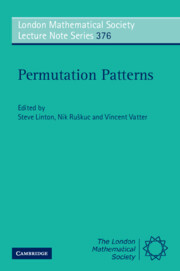Book contents
- Frontmatter
- Contents
- Preface
- Some general results in combinatorial enumeration
- A survey of simple permutations
- Permuting machines and permutation patterns
- On three different notions of monotone subsequences
- A survey on partially ordered patterns
- Generalized permutation patterns – a short survey
- An introduction to structural methods in permutation patterns
- Combinatorial properties of permutation tableaux
- Enumeration schemes for words avoiding permutations
- The lexicographic first occurrence of a I-II-III-pattern
- Enumeration of partitions by rises, levels and descents
- Restricted patience sorting and barred pattern avoidance
- Permutations with k-regular descent patterns
- Packing rates of measures and a conjecture for the packing density of 2413
- On the permutational power of token passing networks
- Problems and conjectures
- References
Enumeration schemes for words avoiding permutations
Published online by Cambridge University Press: 05 October 2010
- Frontmatter
- Contents
- Preface
- Some general results in combinatorial enumeration
- A survey of simple permutations
- Permuting machines and permutation patterns
- On three different notions of monotone subsequences
- A survey on partially ordered patterns
- Generalized permutation patterns – a short survey
- An introduction to structural methods in permutation patterns
- Combinatorial properties of permutation tableaux
- Enumeration schemes for words avoiding permutations
- The lexicographic first occurrence of a I-II-III-pattern
- Enumeration of partitions by rises, levels and descents
- Restricted patience sorting and barred pattern avoidance
- Permutations with k-regular descent patterns
- Packing rates of measures and a conjecture for the packing density of 2413
- On the permutational power of token passing networks
- Problems and conjectures
- References
Summary
Abstract
The enumeration of permutation classes has been accomplished with a variety of techniques. One wide-reaching method is that of enumeration schemes, introduced by Zeilberger and extended by Vatter. In this paper we further extend the method of enumeration schemes to words avoiding permutation patterns. The process of finding enumeration schemes is programmable and allows for the automatic enumeration of many classes of pattern-avoiding words.
Background
The enumeration of permutation classes has been accomplished by many beautiful techniques. One natural extension of permutation classes is pattern-avoiding words. Our concern in this paper is not attractive methods for counting individual classes, but rather developing a systematic technique for enumerating many classes of words. Four main techniques with wide success exist for the systematic enumeration of permutation classes. These are generating trees, insertion encoding, substitution decomposition, and enumeration schemes. In this paper we adapt the method of enumeration schemes, first introduced for permutations by Zeilberger and extended by Vatter to the case of enumerating pattern-restricted words.
Definition 1.1. Let [k]n denote the set of words of length n in the alphabet {1, …, k}, and let w ∈ [k]n, w = w1 … wn. The reduction of w, denoted by red(w), is the unique word of length n obtained by replacing the ith smallest entries of w with i, for each i.
Information
- Type
- Chapter
- Information
- Permutation Patterns , pp. 193 - 212Publisher: Cambridge University PressPrint publication year: 2010
References
Accessibility standard: Unknown
Why this information is here
This section outlines the accessibility features of this content - including support for screen readers, full keyboard navigation and high-contrast display options. This may not be relevant for you.Accessibility Information
- 4
- Cited by
